
Dimdima
Online Children's Magazine from India

Dimdima
Online Children's Magazine from India
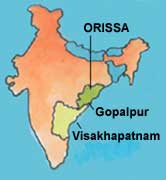
Our journey north from Visakhapatnam, takes us along one of the longest beach roads of our country. Twenty-four kilometres up this road at the mouth of the river Gosthani is the picturesque town of Bheemunipatnam.
 It was a Dutch stronghold in the 17th century. Remnants of a Dutch settlement, a ruined fort, some cannons and an old cemetery are still to be seen. Tne beautiful beach, one of the best on the eastern coast, and the lush green palm groves have made Bheemunipatnam a tourist resort.
It was a Dutch stronghold in the 17th century. Remnants of a Dutch settlement, a ruined fort, some cannons and an old cemetery are still to be seen. Tne beautiful beach, one of the best on the eastern coast, and the lush green palm groves have made Bheemunipatnam a tourist resort.
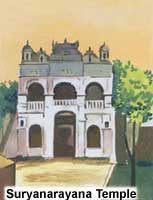 Srikakulam district is the northernmost district on the coast of Andhra PraGesh. The only temple in Andhra dedicated to Lord Suryanarayana or the Sun God is iocated at Arasavalli in the Srikakuiam district. This temple is constructed in such a way that twice a year the sun's rays fall on the feet of the deity. The temple was rebuilt in 1778 A.D. by Yelamanchili Pullaji Panthulu.
Srikakulam district is the northernmost district on the coast of Andhra PraGesh. The only temple in Andhra dedicated to Lord Suryanarayana or the Sun God is iocated at Arasavalli in the Srikakuiam district. This temple is constructed in such a way that twice a year the sun's rays fall on the feet of the deity. The temple was rebuilt in 1778 A.D. by Yelamanchili Pullaji Panthulu.
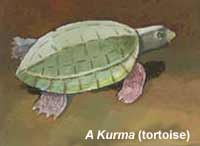 Our next destination is Srikurmam ('holy tortoise'), a seaside town, which takes its name from the famous temple of Vishnu located here. It is the country's only temple where Lord Vishnu is worshipped as a tortoise, the second of his ten avatars.
Our next destination is Srikurmam ('holy tortoise'), a seaside town, which takes its name from the famous temple of Vishnu located here. It is the country's only temple where Lord Vishnu is worshipped as a tortoise, the second of his ten avatars.
It is believed that if the bones of the dead are thrown into the Swetapushkarani tank at the temple, they get transformed into tortoises or kurmas.
Machkund, a sub-tributary of the Godavari which flows along the northern tip of the Srikakulam district, forms the boundary line between the states of Andhra Pradesh and Orissa. The Machkund Thermal Station was commissioned in August 1955. It was the first successful joint venture of the two states.
In ancient times, much of present-day Orissa together with the northern coastal strip of Andhra Pradesh formed the country of Kalinga.
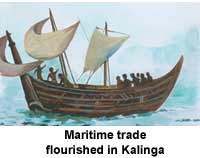 Kalinga was well-known for its maritime trade which extended to Ceylon (Sri Lanka), Burma (Myanmar), Indonesia and other countries in eastern Asia. The first Aryan emigration to Ceylon took place from the shores of Kalinga. Trade flourished from ports like Paloura (of Mahabharata fame), Alba and Charitrapura.
Kalinga was well-known for its maritime trade which extended to Ceylon (Sri Lanka), Burma (Myanmar), Indonesia and other countries in eastern Asia. The first Aryan emigration to Ceylon took place from the shores of Kalinga. Trade flourished from ports like Paloura (of Mahabharata fame), Alba and Charitrapura.
Kalinga played an important role in India's history because it was after the Battle of Kalinga that Ashoka, the great Mauryan emperor gave up his policy of expanding his empire by conquest, and turned to Buddhism.
Orissa reached the zenith of her glory between the 4th and 13th centuries under the Kesari and the Ganga rulers. In 1949, two years after India became independent, the 26 tiny principalities of the province of Orissa merged to form the present state of Orissa.
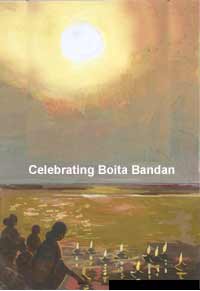 Though Orissa lost its mariIme greatness during the British rule, the Oriyas keep alive the memories of the maritime prowess of their forefathers by celebrating Boita Bandan or salutation to the ship on the full moon night of Kartik Purnima every year. They propitiate the gods in the manner of their seafaring ancestors, and then set afloat small bamboo-boats bearing lighted earthern lamps in the rivers and the sea.
Though Orissa lost its mariIme greatness during the British rule, the Oriyas keep alive the memories of the maritime prowess of their forefathers by celebrating Boita Bandan or salutation to the ship on the full moon night of Kartik Purnima every year. They propitiate the gods in the manner of their seafaring ancestors, and then set afloat small bamboo-boats bearing lighted earthern lamps in the rivers and the sea.
Mihir Sen, the first Indian to swim the English Channel, once organisEd a sail boat expedition from Paloura to Indonesia to retrace the ancient sea route from Kalinga to Java. The boat used was a 40-foot, double masted wooden one that resembled the original sail boats of Kalinga.
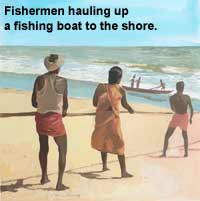 Gopalpur is a quiet and enchanting beach town in southern Orissa. The British renamed it Gopalpur-on-Sea. The people here still follow age-old traditions. The women wake up at dawn, sweep the streets opposite their homes and make beautiful patterns in front of their doorsteps with riceflour powder. Just before the sun rises, people gather on the beach and wait with bowed heads and folded hands to greet the first rays of the giver of life and light. Then after offering flowers and chanting a prayer of gratitude to the sun, they take a holy dip in the waters of the sea.
Gopalpur is a quiet and enchanting beach town in southern Orissa. The British renamed it Gopalpur-on-Sea. The people here still follow age-old traditions. The women wake up at dawn, sweep the streets opposite their homes and make beautiful patterns in front of their doorsteps with riceflour powder. Just before the sun rises, people gather on the beach and wait with bowed heads and folded hands to greet the first rays of the giver of life and light. Then after offering flowers and chanting a prayer of gratitude to the sun, they take a holy dip in the waters of the sea.
White marker-poles can be seen on the high sand dunes on the beach. These poles help to guide the fishermen out at sea during the daytime. The lighthouse on the beach guides them at night.
The fishermen here wear conical hats that distinguish them from other fishermen in Andhra and Bengal.
Last updated on :9/13/2005
Dimdima is the Sanskrit word for ‘drumbeat’. In olden days, victory in battle was heralded by the beat of drums or any important news to be conveyed to the people used to be accompanied with drumbeats.
Bharatiya Vidya Bhavan
K. M Munshi Marg,
Chowpatty, Mumbai - 400 007
email : editor@dimdima.com
Bharatiya Vidya Bhavan
505, Sane Guruji Marg,
Tardeo, Mumbai - 400 034
email : promo@dimdima.com
Dimdima.com, the Children's Website of Bharatiya Vidya Bhavan launched in 2000 and came out with a Printed version of Dimdima Magazine in 2004. At present the Printed Version have more than 35,000 subscribers from India and Abroad.